
Want to dodge the chaos and clinch success in your digital marketing agency? Smooth sailing through projects — be it building a skyscraper or creating a slick app launch — starts with savvy project management.
The catch?
Without a game plan, you're steering into a storm of missed deadlines, muddled goals, and a Godzilla of a project scope that threatens to smash your plans to smithereens.
Fear not. Our project management playbook is here to turn potential bedlam into your best laid plans. Read on for the winning move and hit your project goal with ease.
What are the different PM processes?

Project management is the backbone of any digital marketing agency, and it all boils down to nailing five phases of project management.
The first is the project initiation phase, or kick off, where you pitch the project's worth Then, dive into planning and plot out your roadmap to victory with a project charter.
When you hit execution, it’s showtime — where you exit the planning phase and bring the project to life. Keep a keen eye during the project monitoring phase to stay the course and prevent the scope creep monster from rearing its fugly head.
Finally, seal the deal in the closure phase, where a round of high-fives from stakeholders awaits. But remember, the secret sauce is in the method—pick the right one to hit your targets.
Remember, the 5 stages of project management can be challenging and confusing to handle. But things will be easier after using the following project management process techniques:
Waterfall vs. Agile
Agile and waterfall are reliable project management methodologies you can use to run projects effectively. The two are suitable for different projects, though they're mainly used for software development.
However, their main differences are budget, timeframe, and flexibility. But they have the same goal of making clients happy and satisfied. Despite that, they perform similar tasks like designing, developing, and testing. Their foundation is identical, as they plan and monitor the project's milestones.
Let's delve deeper into the two methodologies:
Waterfall Methodology

Waterfall methodology is a project management technique that helps project managers know a given task's end result before its implementation. It's a simpler methodology with given requirements and steps to follow. The linear form of project management works best when every stage's deliverables are clear and necessary for the next phase in the project management life cycle.
Cons
- The waterfall method requires more time as the next initiation phase occurs after the successful completion of the previous stage.
- Your flexibility limited, as you must outline the whole project before it begins.
Agile Methodology
On the other hand, agile is a much more flexible project management methodology since you can change it at various stages. It encourages collaboration between key stakeholders and best suits short-deadline projects. In this technique, the project management team works on different phases concurrently, saving time for short deadlines.
Pros
- The best thing about this methodology is that all team members are part of the project execution. This promotes collaboration, productivity, and team empowerment.
- Saves time and more effectively protects the project's scope.
Cons
- Since the team works on different phases simultaneously, it's less flexible and making any changes can cost precious time.
- It's also challenging to determine the project's timeline, and having all the project team members on the same page is difficult.
- Agile methodology also encourages miscommunication or misplacement of the project's vital information, especially if some project team members leave before the completion of the project.

Success stories for each methodology
An example where agile methodology has worked effectively is at IBM and its recruitment. Initially, IBM struggled to manage big projects. The organization kept adding more people to the project, which made it take longer.
The organization had challenges recruiting and retaining top talent to improve performance and project management. However, after adopting the agile methodology, efficiency at IBM increased drastically. The methodology helped IBM identify its goals. Then it gave self-selected teams the power to lead, which empowered employees and increased engagement.
The waterfall methodology has been notably successful within the construction sector, where the project management process inherently demands a linear progression.
Consider the intricate process of bridge construction — a project that must comply with stringent safety standards and myriad governmental regulations long before the first steel beam is ever set. The foundation must be meticulously engineered and laid down as a precursor to the subsequent construction phases, each of which builds upon the last, with progress rigorously monitored throughout.
Agile Approaches: Scrum, Kanban, and More
Most project managers for digital marketing agencies prefer the agile project management methodology because it has more advantages. This makes agile approaches like Scrum or Kanban a good solution, resulting in an agile mindset.

An agile mindset is willing to learn, understand, and collaborate with other team members. It encourages flexibility, allowing the team members to use different tools and processes to make changes that meet set goals and customers' needs.
An agile mindset is important in the current world as it results in an agile environment that prevents project management chaos at the workplace.
Below are the agile methodologies that create an agile mindset, resulting in client satisfaction, quality assurance, and facilitating communication between team members:
Scrum
IT environments and other similar industries frequently use this methodology. In the scrum method, developmental stages (project breakdown) are called sprints. Each sprint is given enough time for project planning and management. It emphasizes collaboration and efficient execution of tasks through a scrum board that contains different columns.

All you need to do is assign a scrum leader and product owner who manages the rest of the team to meet the set target under a tight deadline.
Remember, the product owner, scrum master, and development team members are the main scrum roles you must understand well. The projects using this methodology can take between 1-4 weeks, and it supports collaboration between different departments.
Benefits of Scrum
Using scrum for business project management process comes with a lot of benefits, including:
Flexibility
Scrum allows you to make product definition change requests and deliver them with fewer bottlenecks. However, you must modify the backlog items to enable them to match the necessary product changes.
Results in Better Sprint Goals
During sprint planning meetings, the scrum team creates a sprint interval with clear goals. The goals help the team know how much work they can manage. Setting realistic goals that don't exceed the team's capacity is important for reducing potential risks. Looking at the sprint backlog items that contain the goals will make things easier on PMs.
Kanban

With the Kanban method, you'll document the daily workflow and processes in a visual, "board" style. Through the Kanban board, you can see the project's progress and what’s next, which promotes transparency.
The Kanban board has 3 columns: the “To Do,” “Doing,” and “Done” segments for visualizing the scope of the project, deliverables, and milestones from start to finish.
After going through the task board, list the work in progress. However, you can improve the Kanban board's performance by integrating it with different project management software.
Advantages
- Promotes transparency.
- Easy to use because of the 3 segments that help visualize the project.
- Allows for other project management software integrations.
Disadvantages
Apart from the two agile approaches, you can also use the following:
- XP (Extreme programming)
XP mainly focuses on customer delivery and continuous development through sprints or intervals. It has 12 supporting processes like small releases, simple design, and pair programming.
- Lean
Even though most people consider lean an agile approach, it's a different methodology. However, they share some values that make them share a grouping. Lean's main principles are:
- Increasing the team's body of knowledge
- Eliminating waste and improving resource management
- Improving quality and quality assurance
Need Structure? Try PRINCE 2
If you need structure, work with the Prince 2 project management process methodology, which is scalable and accepted globally. It has an updated framework that helps organizations implement projects using a consistent approach.
Prince 2 allows for regular reviews of the progress and project plan. It's the recommended methodology where the business project management process requires comprehensive documentation, clear roles, and structured control. It's beneficial when handling complex projects and provides a standardized approach for larger teams and organizations.
Advantages
- It has an updated framework for consistency.
- Allows for regular progress and project plan reviews.
Disadvantages
- It best suits complex projects
Need precise scheduling? Try Critical Path Method (CPM)

You can also use CPM for critical activities that require urgent attention to prevent project delays. Remember, if any task on the critical path is delayed, the whole project is delayed. Project managers use the critical path method to avoid chaos and develop the right project schedule.
CPM contains the task sequences and a network diagram visually representing the project's duration. This method best suits projects with fixed closing dates and limited resources, as it accurately estimates time and identifies budget constraints.
Advantages
- Best suited for urgent projects
- Includes time and budget estimates for better resource allocation
Disadvantages
- A simple mistake risks delaying the entire project
Need to improve efficiency? Try Lean Project Management
Lean project management is an ideal project management process for manufacturing firms. It emphasizes increasing value and reducing waste by eliminating worthless streams in the lean manufacturing process.
We recommend this method when you want to optimize processes and reduce unnecessary, burdensome steps.
Lean project management helps improve visibility in the manufacturing process while increasing productivity and morale. TPS is a lean project management process with an example that saw the company enhance value for its customers.
Advantages
- Highly effective at optimizing the manufacturing process
- Reduces unneccessary steps
Disadvantages
- Only effective for manufacturing businesses
Are requirements uncertain? Try Adaptive Project Framework (APF)
Alternatively, you can use this traditional project management phase, APF, when the process requirements are uncertain. It accommodates unknown issues that come up when handling a project.
Consider this project management process because it prepares team members for the unexpected and how to respond. Its major principle is to “learn by doing,” which enables teams to adjust based on feedback and changing needs. This means this process focuses on and promotes adaptability.
Need high-quality software development? Extreme Programming (XP) is your choice
Extreme programming can come to your rescue when you want to work on high-quality software development. It focuses on continuous development and customer delivery according to your clients' changing requirements.
This customer-centered approach ensures teams use feedback to deliver the best product. The teams can interact with the end-users to test if the software is operational.
Need quality improvement? Use Six Sigma
Are you still struggling with answering this question:
What is the project management process? Then, you need to use the Six Sigma approach, which defines, measures, analyzes, designs, and verifies quality improvement.
The methodology helps improve output quality by identifying and eliminating the cause of defects.
To do this, the Six Sigma process using a set of quality management techniques that are statistical and empirical. An expert monitors the process to ensure it meets the desired quality.
This method best fits situations where process optimization and quality control are critical.
What If You Are in Need of More than One Factor?
If you need more than one factor, the hybrid approach is the best way to go. The hybrid strategy lets you incorporate different elements from various methodologies. For example, you can use CPM and Six Sigma to improve quality over time.
How To Exactly Determine the Right One For You?
Project management can be one of the most frustrating processes for an organization. However, this gets easier after understanding the project management process with examples. Take your time and consider the project management team.
Also, know what the key stakeholders want and the project deliverables. Do trial runs and work with experts to understand the best methodology for your project or organization.
Power up your project management game
It's time to unite your project managers and team members in a seamless collaboration dance. From planning to execution, tracking to triumph, manage your projects on time, every time, and nail those organizational goals. Whether you're all about Waterfall, Agile, Prince2, CPM, APF, XP, or Six Sigma, there's a method to match your madness.
To recap:
- Project management is the process that encourages collaboration between project managers and team members.
- The team plans, executes, tracks, and completes projects within a set timeline to meet the organization's goals.
- The main project management processes include waterfall and agile.
- Another important type of project management process example is Prince 2.
- But CPM, APF, XP, and Six Sigma approaches can also work depending on the organization, project sponsor, or team members.
But why stop there? Partner with the project management experts at ScaleTime for expert guidance and to craft a unified system that cuts through the chaos.
Let's turbocharge your digital marketing agency's growth and blast past those targets. Hit us up and watch your profits soar and performance peak.
Ready, set, grow!

.jpg)



















%20(1).gif)
